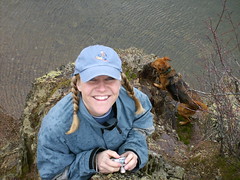I have a penchant for sound effects. In fact, I think all abbreviations should be able to be pronounced as one noise rather than requiring spelling out the letters. For instance, in my field GIS should be pronounced jiz, ESRI should be ezry, SQL has appropriately been coined sequel.
Tim was asking me a code question this morning and I started rambling off ASP.Net code, "ASP repeater a href equals chikt percent pound container dot DataItem parenthesis quote variable quote parenthesis percent chikt".
At which point Tim asked, "What's a chikt?"
I explained, "Oh, sorry I just pronounced a carrot (<)."
To which Tim replied, "I thought you were speaking a click language."
And with that we were off. We flew into a discussion of the Khoisan "Bushmen" of the Kalahari Desert, their unusual language and physical characteristics:
Physically the Khoisan, with their short frames (149-163 cm/4'9-5'4; Coon 1965), copper brown skin, tightly coiled "peppercorn" hair, high cheekbones, and epicanthic eye folds are quite distinct from the darker-skinned peoples who constitute the majority of Africa's population. They have moderately long legs with long bellies, which is a trait that sharply distinguishes them from surrounding Pygmy and Bantu populations having muscles with short bellies and long tendons (Coon 1965). Two distinguishing features of some Khoisan women are their elongated labia minora and tendency to steatopygia, features which contributed greatly to the European fascination with the so-called Hottentot Venus. However, the physical differences between Khoisan and other peoples may be diminishing due to intermarriage.
Source: Wikipedia
And if I remember correctly from my professor in World Regional Geography, "Khoisan males maintain a semi-erect state at all times. The lack of which" he emphasized, "they find both humorous and a sign of weakness."
This is a difficult thing to research while at work, but I was able to confirm at least the first part of my professor's statements in the Swaziland National Trust Commission's discussion of the
Nsangwini Rock Paintings.

Nsangwini Bird Men
Photographer: Bob Forrester
Source:
Swaziland National Trust CommissionThe most publicized paintings at Nsangwini (which have appeared on Swaziland stamps) are two winged figures, these are part human and part bird or insect. The right-facing figure is floating as if airborne, while the other may be hovering, so light is the painter's touch. The significance of the half-completed animal on their left is not apparent, but the procession of four male figures towards a crack in the rock evokes a response similar to that of the 'body in the crack'.
This view seems to be supported by the fact that all four figures have infibulated penises, or have penis ornaments which have some unknown ritual significance. Bushmen had permanently semi-erect penises. The foreskin was perforated and a plug was inserted and worn at all times except when men were sexually active. Each figure is brandishing a branch or a handful of plants. This is similar to those being carried by two (of four) men in a much publicized painting at Sehonghong in Lesotho. This portrays a captive rain animal being led by four shamans in order to attract rain. These branches or bunches could be of aromatic or even hallucinogenic plants, which also had ritual significance. They may have been used to pacify the rain animal, which could be a hippopotamus or a look-a-like mythical animal from the river.
Ironically, this is why I love coming to work. To learn things like this.
Why just earlier this morning I was corrected by my co-worker to learn that Pelé does not mean "flying snake" like I remembered (who knows where I got that from), but instead was the result of young Pelé's mispronunciation of the name of his favorite player, Vasco da Gama goalkeeper Bilé.
Source: Wikipedia
 Finally, there will be a generation of Americans who will know that:
Finally, there will be a generation of Americans who will know that:







